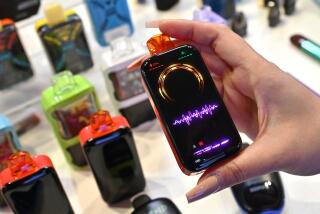Teens don’t find soft drinks so sweet if seeing sweat equivalents
- Share via
Think nothing gets through to teenagers when it comes to making better dietary choices? Try telling the texting, video-game-playing, sofa-bound generation what it’ll take to burn off the calories in one of their favorite soft drinks and they will run -- not walk, run! -- for the bottle of water beside it, a new study suggests.
A message that required a bit more calculation -- the percentage of daily calorie intake a soda represents -- also succeeded in discouraging the purchase of sugar-sweetened beverages. But the study, published Tuesday in the American Journal of Public Health, found that translating those calories into time on the track had the greatest effect.
The new research was conducted at corner stores in low-income, predominantly African American neighborhoods of Baltimore. Between April and October 2011, researchers from Johns Hopkins University’s Bloomberg School of Public Health and Columbia University’s Mailman School of Public Health set out to explore whether and how teenagers living in those communities responded to different messages about the calories in beverage choices.
After gathering data on teens’ usual beverage purchasing behavior at small markets within a few blocks of high schools or middle schools, researchers posted one of three different signs prominently near the refrigerator where beverages were held. The signs rotated through each store for several weeks, with periods in between when no signs were posted. And researchers waited and watched, collecting data on teen purchasers and their choices.
The first sign indicated simply how many calories were in the average sugar-sweetened beverage -- soda, sports drink, energy drink or fruit drink -- for sale. “Did you know that a bottle of soda or fruit juice has about 250 calories?” asked a brightly colored sign posted on each beverage case in each corner store. The second sign told potential purchasers what percentage of a recommended daily caloric intake a soft drink represented: “Did you know that a a bottle of soda or fruit juice has about 10% of your daily calories?” it asked.
In creating the third sign, researchers were not looking to translate soda calories into fun. Instead of calculating 250 calories into basketball or dancing, they chose to convert those calories into the currency of jogging, “because of research suggesting that unfavorable information is more persuasive to consumers.” The signs read, “Did you know that working off a bottle of soda or fruit juice takes about 50 minutes of running?”
The result: Teens who saw soda calories converted to 50 minutes of running were half as likely to buy a sugar-sweetened beverage as those who saw no sign at all. Those who were told what percentage of daily calories a soda constitutes were 40% less likely to buy such a beverage as those who saw no message. And those who saw calories only were not significantly less likely to buy a sweetened soft drink than those who saw no message.
The signs were particularly effective in discouraging the purchase of sweetened iced tea and sports drinks, and in increasing sales of water.





